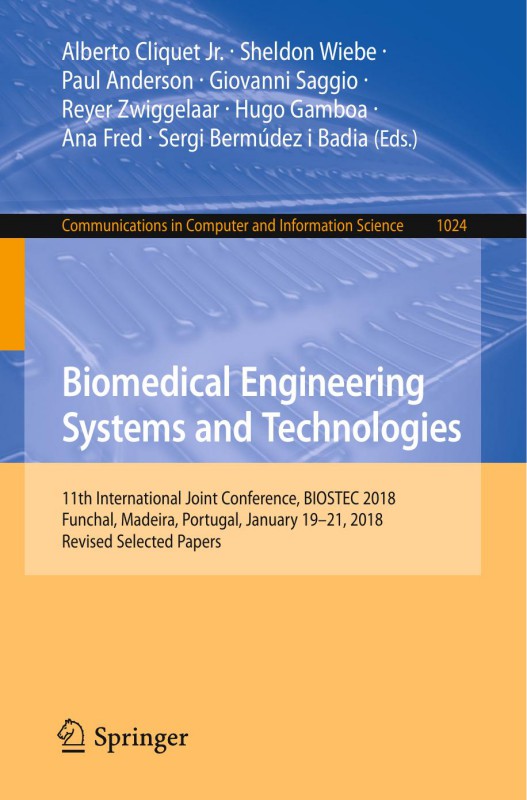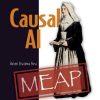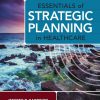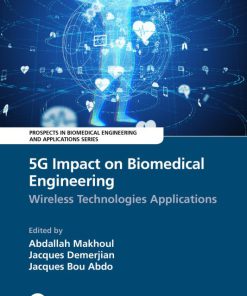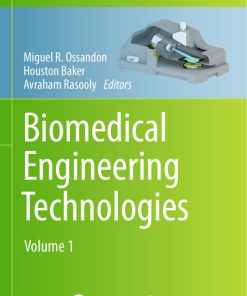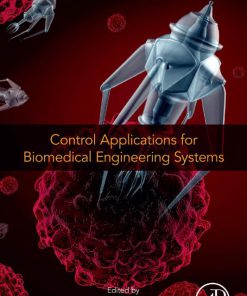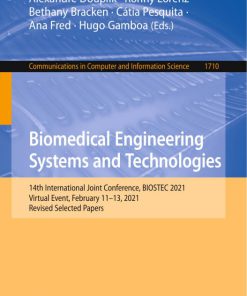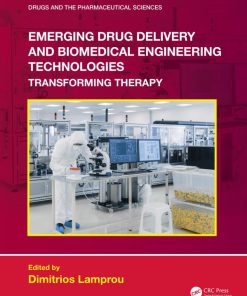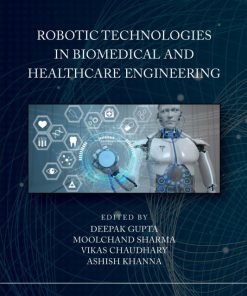(Ebook PDF) Biomedical Engineering Systems and Technologies 1st edition by Alberto Cliquet Jr, Sheldon Wiebe 3642382568 9783642382567 full chapters
$50.00 Original price was: $50.00.$25.00Current price is: $25.00.
Authors:Alberto Cliquet Jr Sheldon Wiebe , Series:Biomedical [51] , Author sort:Wiebe, Alberto Cliquet Jr Sheldon , Languages:Languages:eng , Published:Published:Aug 2019 , Publisher:Springer
Biomedical Engineering Systems and Technologies 1st edition by Alberto Cliquet Jr, Sheldon Wiebe – Ebook PDF Instant Download/DeliveryISBN: 3642382568, 9783642382567
Full download Biomedical Engineering Systems and Technologies 1st edition after payment.
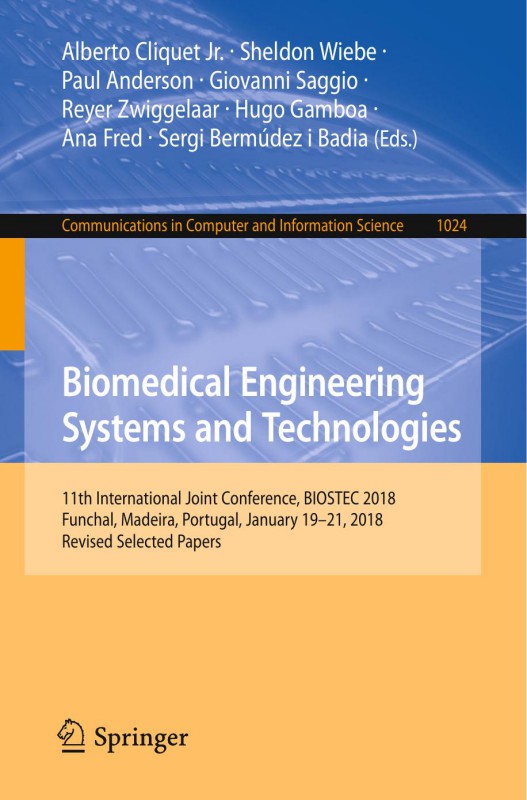
Product details:
ISBN-10 : 3642382568
ISBN-13 : 9783642382567
Author : Alberto Cliquet Jr, Sheldon Wiebe
This book constitutes the thoroughly refereed post-conference proceedings of the 5th International Joint Conference on Biomedical Engineering Systems and Technologies, BIOSTEC 2012, held in Vilamoura, Portugal, in February 2012. The 26 revised full papers presented together with one invited lecture were carefully reviewed and selected from a total of 522 submissions. The papers cover a wide range of topics and are organized in four general topical sections on biomedical electronics and devices; bioinformatics models, methods and algorithms; bio-inspired systems and signal processing; health informatics.
Biomedical Engineering Systems and Technologies 1st Table of contents:
1 Introduction
2 Applications to Ophthalmology
2.1 Quantitative Image e Analysis Applied to OCT Scans
2.2 Structural Alterations of Cerebral Small Arteries in Patients with Essential Hypertension
3 Application to Dentistry and to Orthodontics
4 Vision in Forensic Sciences
5 Vision in Prosthetics
5.1 A Nose Prosthesis
5.2 An Ear Prosthesis
6 Conclusions
References
Part I: Biomedical Electronics and Devices
Dry andWater-Based EEG Electrodes in SSVEP-Based BCI Applications
1 Introduction
2 EEG Acquisition Systems in BCI: Overview
3 Materials and Methods
3.1 Amplifier Technology and Data Acquisition
3.2 EEG Setups with Three Different Electrode Types
3.3 Methods
4 Signal Quality and Performance
4.1 Baseline Performance and the Presence of Noise
4.2 The Impact of Noise Estimation on the Electrode Selection
4.3 SSVEP Discrimination Power and Electrode Selection
4.4 Usage of Harmonics and Different Electrode Number
5 Practical Application
5.1 Stimuli Duration and ITR
5.2 Using Dry and Water-Based Electrode as a Ground
5.3 Convenience and Setup Time
6 Discussion
7 Conclusions
References
Nitrite Biosensing Using Cytochrome C Nitrite Reductase: Towards a Disposable Strip Electrode
1 Introduction
2 Materials and Methods
2.1 Reagents
2.2 Electrochemical Measurements
2.3 Bioelectrodes Preparation
3 Results
3.1 Effect of the Carbon Ink on the Bioelectrode Response
3.2 Electrode Optimization
3.3 Analytical Parameters
3.4 Application of Carbon Paste Screen Printed Electrodes (CPSPEs)
3.5 Interferences
4 Conclusions
References
A Real-Time and Portable Bionic Eye Simulator
1 Introduction
2 SystemSetup
3 System Implementation
3.1 Visuotopic Mapping
3.2 Averaging Sampler
3.3 Thresholding
3.4 Phosphene Modelling
3.5 Frame Rate Reduction
3.6 Threshold Ramping
3.7 Extra Functions
4 Experimental Setup
4.1 Maze Test
4.2 Chessboard Test
4.3 Ball Interception Test
5 Results and Discussion
5.1 Maze Test
5.2 Chessboard Test
5.3 Ball Interception Test
5.4 Discussion
5.5 Limitations of the System
6 Conclusions and Future Work
References
Pathogen Detection Using Magnetoelastic Biosentinels
1 Introduction
2 Theory of the Biosentinel
2.1 The Resonator Platform
2.2 Biosentinel Motion
2.3 Fabrication of ME Resonators
2.4 Immobilization of the Biorecognition Layer
3 Characterization of ME Biosentinel Performance
3.1 Detection of Pathogens by the ME Sentinels
4 Conclusions
References
Multi-source Harvesting Systems for Electric Energy Generation on Smart Hip Prostheses
1 Introduction
1.1 Scope of the Problem and Background
1.2 Method
1.3 Paper Contribution
1.4 Main Conclusions
1.5 Outline
2 The New Concept of Smart Hip Prosthesis
3 Material and Methods
3.1 Hip Prosthesis Prototype
3.2 Translation-Based Electromagnetic Power Generator (TEEH)
3.3 Rotation-Based Electromagnetic Power Generator (REEH)
3.4 Piezoelectric Power Generator (PEH)
4 Experimental and Simulation Results
4.1 TEEH Results
4.2 REEH Results
4.3 PEH Results
5 Discussion
5.1 Need for Multi-source Harvester Systems
5.2 Choice of the Energy Harvesting Method
5.3 Performance of the Linear Models
5.4 Optimization of the Multi-source Harvester System
6 Conclusions
References
An Integrated Portable Device for the Hand Functional Assessment in the Clinical Practice
1 Introduction
2 Related Works
3 The Hand Functional Assessment Device
3.1 Hardware Architecture
3.2 Embedded Control Software
4 The Advanced Stand Alone Physician Interface
5 Device Application in an Outpatient Clinic
6 Conclusions
References
Part II: Bioinformatics Models, Methods and Algorithms
Forests of Latent Tree Models to Decipher Genotype-Phenotype Associations
1 Introduction
2 Definitions
3 Motivation and Related Work
3.1 Motivation
3.2 Probabilistic Graphical Models toModel Linkage Disequilibrium
3.3 Learning Latent Tree Models
4 The Learning Algorithm
4.1 Outline of the Algorithm
4.2 Details of the Algorithm
4.3 Role of Parameters
5 Evaluation
6 Protocol to Assess the Suitability of FLTM to Association Genetics
6.1 Simulation of Realistic Genotypic Data
6.2 Choice of the Association Test
6.3 Adapted Correction for Multiple Testing
7 Detection of Indirect Genetic Associations
7.1 Verification for Simulated Data
7.2 Confirmation on Real Data
8 Conclusions
References
Laser Doppler Flowmeters Prototypes:Monte Carlo Simulations Validation Paired with Measurements
1 Introduction
2 Materials and Methods
2.1 Prototypes
2.2 Phantom and Simulation Models
2.3 Measurements
3 Results and Discussion
3.1 Phantom
3.2 Skin
3.3 Rat Brain
4 Conclusions
References
Simulation of Prokaryotic Genome Evolution Subjected to Mutational Pressures Associated with DNA Rep
1 Introduction
2 Materials and Methods
3 Results
4 Discussion
References
Single Tandem Halving by Block Interchange
1 Introduction
2 Preliminaries: Duplicated Genomes, Rearrangement, Genome Halving Problems
2.1 Duplicated Genomes
2.2 Rearrangements
2.3 Single Tandem Halving
3 Lowerbound for the BI Single Tandem Halving Distance
4 Formula for the BI Single Tandem Halving Distance
5 Sorting Algorithm
6 Conclusions
References
Fast RNA Secondary Structure Prediction Using Fuzzy Stochastic Models
1 Introduction
2 Preliminaries
2.1 Sampling Based on SCFG Models
2.2 Considered Disturbance Types and Levels
2.3 Influence of Disturbances
3 Reducing the Preprocessing Time
3.1 Basic Idea
3.2 Approximation of Emission Probabilities
3.3 (Improved) Approximated Sampling Probabilities
4 Considered Sampling Strategies
4.1 Well–Established Strategy
4.2 Alternative Strategy
5 Applications
6 Conclusions
References
A Vaccination Strategy Based on a State Feedback Control Law for Linearizing SEIR Epidemic Models
1 Introduction
2 SEIR Epidemic Model
3 Vaccination Strategy
3.1 Control Parameters Choice
4 Simulation Results
4.1 Epidemic Evolution without Vaccination
4.2 Epidemic Evolution with a Feedback Control Law
5 Conclusions
References
Medical Imaging as a Bone Quality Determinant and Strength Indicator of the Femoral Neck
1 Introduction
2 Image Based Reconstruction of Bone Tissue to Determine Its Strength Characteristics
2.1 CT Based Reconstruction
2.2 MRI Based Reconstruction
2.3 Model Accuracy and Strength Characteristics
3 DXA Strength Indicator of the Femoral Neck
3.1 Materials and Methods
3.2 Results
3.3 FEA Simulation
4 Discussion
5 Conclusions
References
Parallel GPGPU Evaluation of Small Angle X-Ray Scattering Profiles in a Markov Chain Monte Carlo Fra
1 Introduction
2 Methods
2.1 Forward SAXS Computation
2.2 Coarse-Grained ProteinModels
2.3 Form Factor Descriptors
2.4 OpenCL Programming Model
2.5 Efficient GPGPU Implementation
2.6 Monte Carlo Simulation
2.7 Performance Test Configuration
3 Results and Discussion
3.1 Computational Efficiency of the SAXS Modeling
3.2 GPGPU Implementation
3.3 Monte Carlo Performance
4 Conclusions
Source Code Availability
References
Part III: Bio-inspired Systems and Signal Processing
Assessment of Gait Symmetry and Gait Normality Using Inertial Sensors: In-Lab and In-Situ Evaluation
1 Introduction
2 Related Work
2.1 Observational Gait Analysis
2.2 MOCAP Gait Analysis
2.3 Instrumented Gait Analysis
3 Method
3.1 In-Lab Data Collection
3.2 In-Situ Data Collection
3.3 Observational Gait Analysis
3.4 MOCAP Gait Analysis
3.5 Instrumented Gait Analysis
3.6 Data Analysis
4 Results
4.1 In-Lab Evaluation
4.2 In-Situ Evaluation
5 Discussion
6 Conclusions
References
MRI TV-Rician Denoising
1 Introduction
2 Model Equations
3 The Primal Descent Gradient Numerical Scheme
4 A Semi-implicit Formulation
5 Results and Discussion
6 Conclusions
References
Applying ICA in EEG: Choice of the Window Length and of the Decorrelation Method
1 Introduction
2 Problem Statement
2.1 EEG Mixing Model
2.2 EEG Separation Model
2.3 Optimization: Data Rotation
3 Performance Evaluation Criteria
3.1 Reliable Estimate of the Covariance: Riemannian Likelihood
3.2 Separability Performance Index
4 Simulated Data Set
4.1 Random Data Set
4.2 Plausible Data Set
5 Results and Discussion
5.1 Random Data Set
5.2 Plausible Data Set
6 Conclusions and Future Work
References
Electrical Impedance Properties of Deep Brain Stimulation Electrodes during Long-Term In-Vivo Stimul
1 Introduction
2 Materials and Methods
2.1 Animal Treatment
2.2 Stimulation- and Counter-Electrodes
2.3 Electric Impedance Spectroscopy (EIS)
2.4 Electron Microscop py Study of Electrode Encapsulation by Tissue
3 Results
3.1 Electrode Implanta ation
3.2 Chronic Instrumen ntation
3.3 Impedance Measur rement
4 Conclusions and d Perspectives
References
Comparison between Thermal and Visible Facial Features on a Verification Approach
1 Introduction
2 Facial Recognition Approach
2.1 Approach Proposed
2.2 Features Based on Scale-Invariant Feature Transform
2.3 Classifier Based on Vocabulary Tree
3 Experimental Settings
3.1 Databases Used
3.2 Experimental Methodology and Its Results
4 Discussions
5 Conclusions
References
Part IV: Health Informatics
Multiparameter Sleep Monitoring Using a Depth Camera
1 Introduction
2 Related Work
3 System Design
3.1 System Setup
3.2 Depth Image Processing
3.3 Measurement Limitations
4 Experiments
4.1 Experiment I: Sleeping Simulation
4.2 Experiment I I: Realistic Overnight-Sleep Monitoring
5 Discussions
5.1 Head/Torso Detection
5.2 Breath Measureme ent
6 Conclusions
References
Integration of a Heart Rate Prediction Model into a Personal Health Record to Support the Telerehabi
1 Introduction
1.1 Background
1.2 Related Work
1.3 Aim and Scope
2 Methods
2.1 Characteristics and Preparation of the Model Data
2.2 Model Creation
2.3 Model Evaluation
2.4 Personal Health Record System
3 Results
4 Discussion
5 Conclusions
References
Exploiting Cloud-Based Personal Health Information Systems in Practicing Patient Centered Care Model
1 Introduction
2 Remote Patient Monitoring
3 Information Flo ows in PHIS
4 Cloud-Based PHIS
5 PHIS-Ontology
6 Providing Inform mation Flows and Medical Education
7 Transforming X XML-coded Documents
8 Conclusions
References
Online Social Networks Flu Trend Tracker: A Novel Sensory Approach to Predict Flu Trends
1 Introduction
2 Related Work
3 Data Collection
3.1 SNEFT Architecture
3.2 OSN Crawler
4 DataSet
4.1 Text Classification
4.2 Data Cleaning
5 Prediction Model
5.1 Influenza Model Structure
5.2 Cross Validation Test Description
5.3 Cross Validation Results
6 Flu Prediction within Regions
7 Conclusions
References
Clustering of Human Sleep Recordings Using a Quantile Representation of Stage Bout Durations
1 Introduction
2 Methods
2.1 Human Sleep Data
2.2 Descriptive Data Features
2.3 Clustering
2.4 Statistical Significance
3 Results
3.1 Clustering Stability
3.2 Cluster Separation
3.3 Statistical Properties of the Bout Duration Clusters
3.4 Health-Related Cluster Differences
4 Conclusions and Future Work
References
Touch and Speech: Multimodal Interaction for Elderly Persons
1 Introduction
2 Design Guidelines of Multimodal Interactive Systems for Elderly Persons
2.1 Visual Perception
2.2 Speech Ability
2.3 Auditory Perception
2.4 Motor Ability
2.5 Attention and Concentration
2.6 Memory Functionalities
2.7 Intellectual Ability
3 A Formal Unified Dialogue Modelling Approach
3.1 A Unified Dialogue Modelling Approach
3.2 A Formal Language Based Development Toolkit for Dialogue Modelling
4 Multimodal Interactive Guidance System for Elderly Persons
4.1 System Architecture
4.2 The Unified Dialogue Model in MIGSEP
4.3 The Elderly-Friendly Design Elements in MIGSEP
4.4 Interaction with MIGSEP in a Hospital Environment
5 The Experimental Study
5.1 Participants
5.2 Stimuli and Apparatus
5.3 Procedure
5.4 Questions and Methods
6 Results and Discussion
6.1 Effectiveness of MIGSEP
6.2 Efficiency of MIGSEP
6.3 User Satisfaction
7 Conclusions and Future Work
References
Data Integration Solution for Organ-Specific Studies: An Application for Oral Biology
1 Introduction
2 Motivation
3 Methods
3.1 Compilation and Curation of the Saliva Proteome
3.2 Oral Cavity Data Integration
3.3 Oralome Development
3.4 Oralcard Development
4 Results
4.1 Oralome Functionalities
4.2 Oralcard Interface
5 Evaluation
6 Conclusions
People also search for Biomedical Engineering Systems and Technologies 1st:
what is biomedical systems engineering
biomedical systems engineering jobs
what is biomedical engineering technology
what technology do biomedical engineers use
what software do biomedical engineers use

